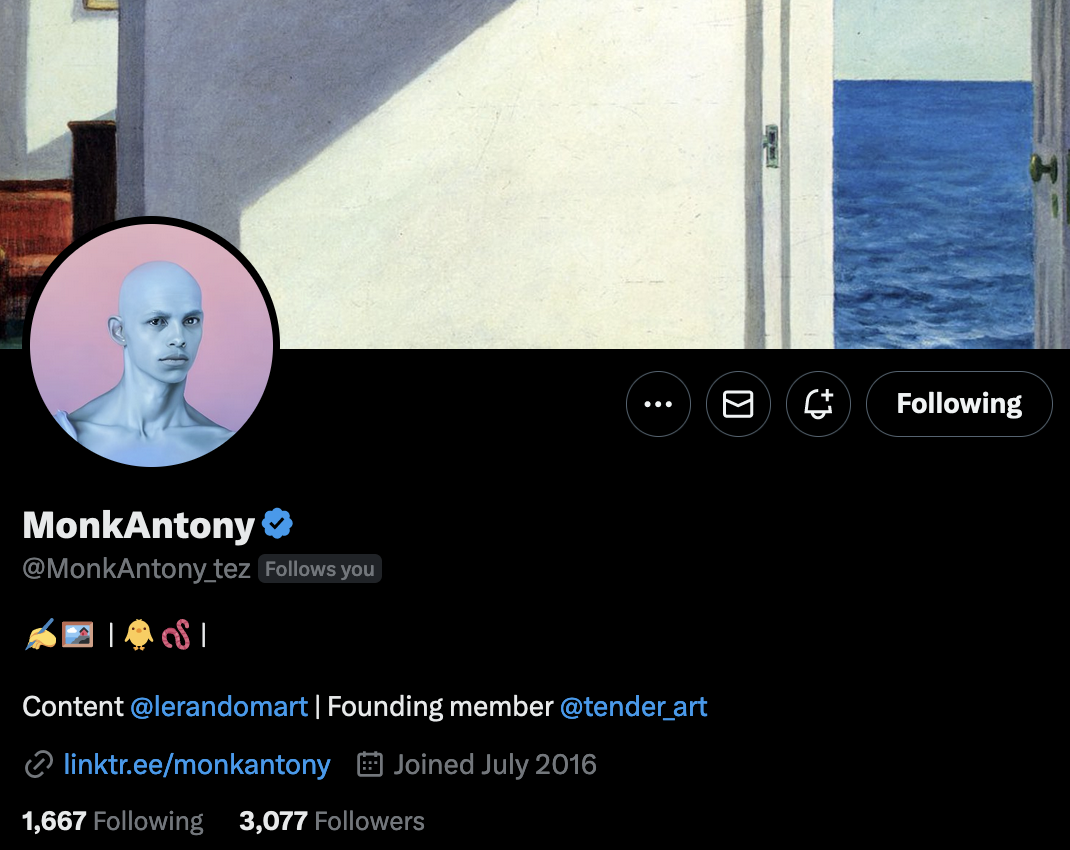Peter Bauman, aka Monk Antony over on Twitter, is the brain behind Le Random's editorial content section. Driven by a deep love for the arts and history, Peter is churning out an impressive number of excellent editorial pieces every week - interviewing leading artists in the space on a regular basis. Currently he is also responsible for building out the most comprehensive timeline on generative art history to date.
Peter Bauman has spent most of his adult life in Asia - living for 12 years in Hong Kong where he's worked in teaching and in finance, and having acquired two masters degrees in international relations he is no stranger to research and writing. After finding his way into Web3 through the FxHash discord and becoming one of the founding members of Tender, he became more and more involved with the community. He made his Web3 writing debut with a Tender editorial piece on Erik Swahn's Farbteiler, one of the earliest projects on FxHash.
In our conversation we talk about the early days of Tender, how it crystallized from a group of like-minded people on the FxHash discord that all shared an interest in generative art. We also talk about what writing in the Web3 space is like, and have a closer look at the process behind putting together the massive timeline that is being put together by LeRandom. Additionally, we discuss the generative art framework that Peter put in place for the analysis of generative art - how it has been received by people, some of their input on it, and how it might evolve in the future.
Tender and the early FxHash Days
Gorilla Sun: Initially, I was going to ask you about yourself and your background - but then I discovered that you'd done an episode with WTBS in which you already do so. I thought that it would be more interesting to try and find some new insights, stories and anecdotes that might be interesting to the readers.
[WTBS episode with MonkAntony]

In the interview you mention that things really took off after you wrote the Tender editorial on Farbteiler. Maybe you could tell us a little about the incidents that led from writing that piece to becoming a founding member of Tender - and at the same time talk a little about how the initial group of people behind Tender came together?
MonkAntony: That's probably something that a lot of people are curious about. It started with Adam Berninger, who is the main founder of Tender. Some of the other people that were involved at the very beginning were Trinity from WTBS, and cosimo who's now part of the FxHash team, essentially through the FxHash discord.
As far as I remember, I think cosi and Trinity reached out to me via DM asking if I wanted to pick a project and write about it, and writing a piece was pretty much how you joined Tender back then. After Adam had curated those first 30-40 projects, that's where the others came in by writing editorials about some of them.
That was in December of 2021, a month or two after FxHash had launched. The first project that came to my mind was Farbteiler because it was one of my favorite early projects. It was a fairly easy choice to join, and I think I was pretty lucky that they'd asked me. Within a month I'd written the piece, and then things continued with the Tender discord.
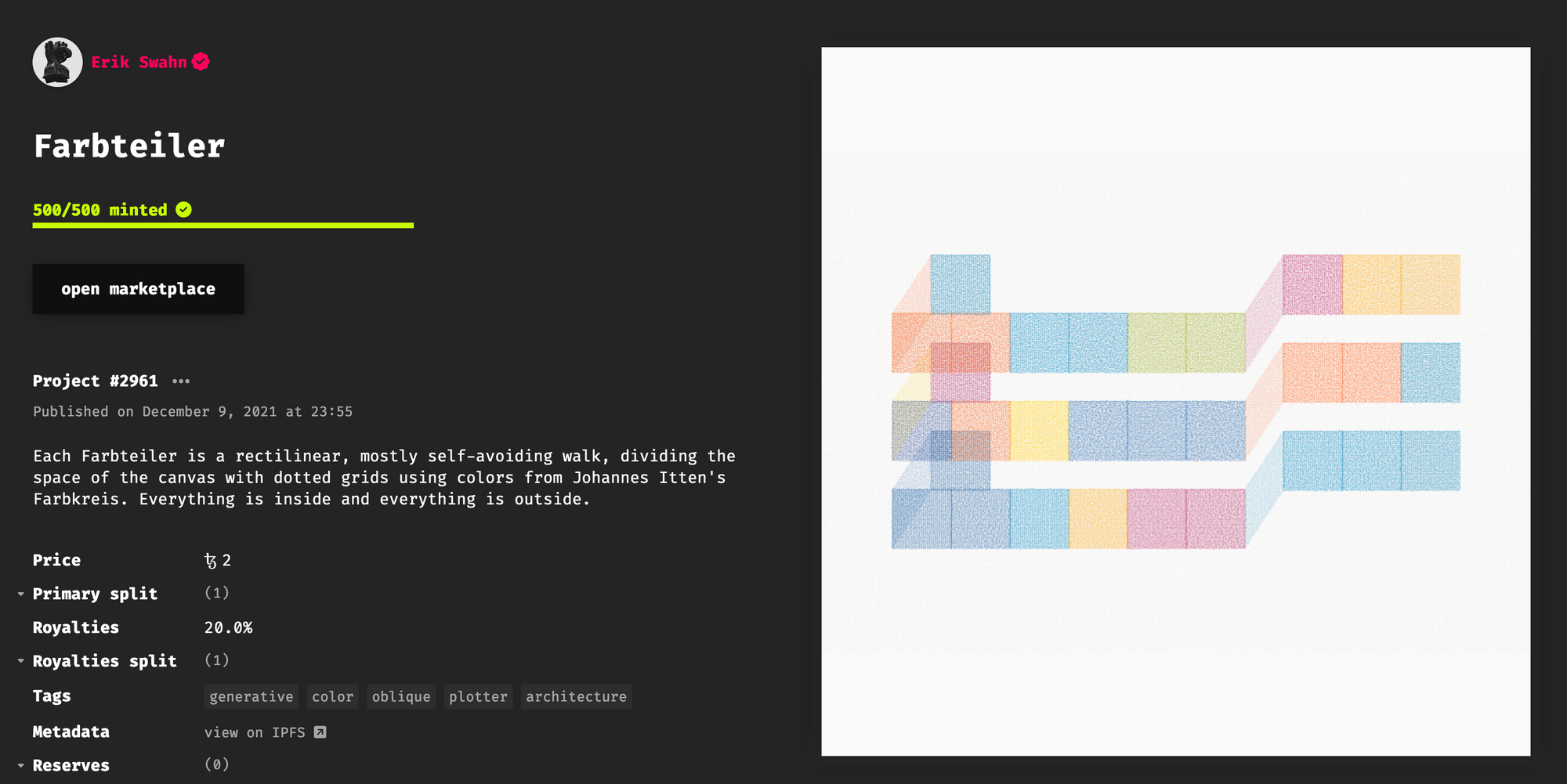
GS: thanks for elaborating, I've been curious about that for a while now. You also mention in the interview that when you first discovered the NFT scene you felt that there were some aspects that were a bit unauthentic.
And I think I know what you mean with that; when I first discovered the NFT scene for myself, it was a bit difficult to fully commit to things because I really couldn't tell what people's motivations and intentions were, alongside NFTs getting a bad rep, I just tried to be cautious. What was this experience like for you?
MA: When I first came into NFTs, maybe like a lot of people, it wasn't through the lens of generative art. You look at the entire landscape by joining all of these different chat groups, discords and communities, maybe you even participate, or you simply watch silently from the sidelines.
A lot of the times with these different kind of communities, once you actually looked beyond the surface, it felt pretty superficial - there wasn't really much to dig into or talk about... with a PFP project, what do you actually talk about after 3 months? 6 months? 2 years? What do you talk about day in day out?
Whereas, with FxHash there's new releases everyday, there's always new artists to discover, there's so much to learn about the movement in general. There was more than enough to talk about right-away.
And it felt authentic. When I joined the FxHash discord, I felt a genuine sense of community, from a group of people that were interested in learning about something new, learning about generative art - especially from people that knew more, the early leaders in the space. That was the first time in Web3 where I felt a community aspect that actually worked and felt real - even more so when I joined the early Tender discord, a bit similar to the (famous) FxHash price-discussion channel, without any of the price discussions - it was only about artists and art.
Being part of those two communities were learning experiences, that it was in fact possible to build genuine communities in the space, which is a difficult and rare to be honest.
GS: FxHash provides something of substance to it's audience, it's not just about NFTs, but also about programming, building things on the blockchain and pushing blockchain use-cases forward. For instance, people are creating some really innovative things with the new code driven params that you don't really see anywhere else.
Enter Le Random
GS: skipping forward a bit - how did the idea for Le Random start?
MA: The idea for Le Random finds its beginnings with thefunnyguys; soon after the editorial piece for Farbteiler was published in February of 2022, he got in touch with me and said that he had a project in mind that we could maybe work on together. Then over the course of the following months we started a long-term chat about art - and back then in February I don't even think that "Le Random" had a name yet. Then thefunnyguys and co-founder Zack worked to raise funds and I joined in November.

Article by thefunnyguys on the original motivations behind Le Random.
Gorilla: besides that who're the other folks behind Le Random?
MA: In total there's 4 people that are core team members at Le Random. We have our co-founder Zack, who’s responsible for operations, and takes care of keeping the lights on behind the scenes. Besides that there's thefunnyguys and Conrad (nemocake/@DISPUTED on Twitter) who're responsible for the collection, and adding new pieces on a regular basis. I take care of the editorial side of things, the content, the timeline, and Twitter stuff.
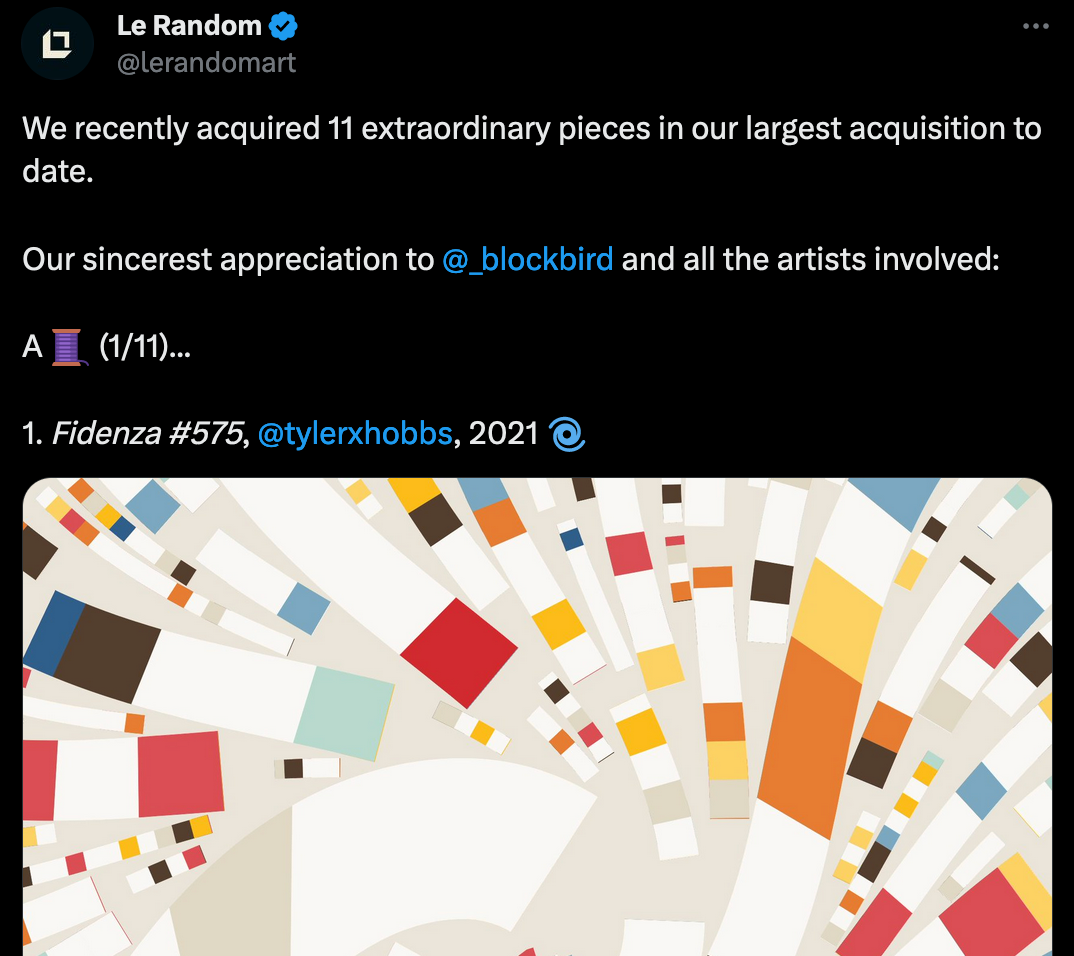
But there's also an overlap; things are definitely not siloed. Conrad helps out with some of the things we tweet out, and I try to help with the collecting as well. But generally that's what we focus on.
GS: that's interesting, I didn't know that Conrad was involved, although I do see him pop up quite frequently on my Twitter timeline. All of this makes me feel like I need to get more on discord.
MA: these days I don't know how people do discord anymore, I'm not on discord anymore really. In 2021-22 I was fortunate to have some time to be a bit more involved, but now I wouldn't know how.
The Timeline and Writing in Web3
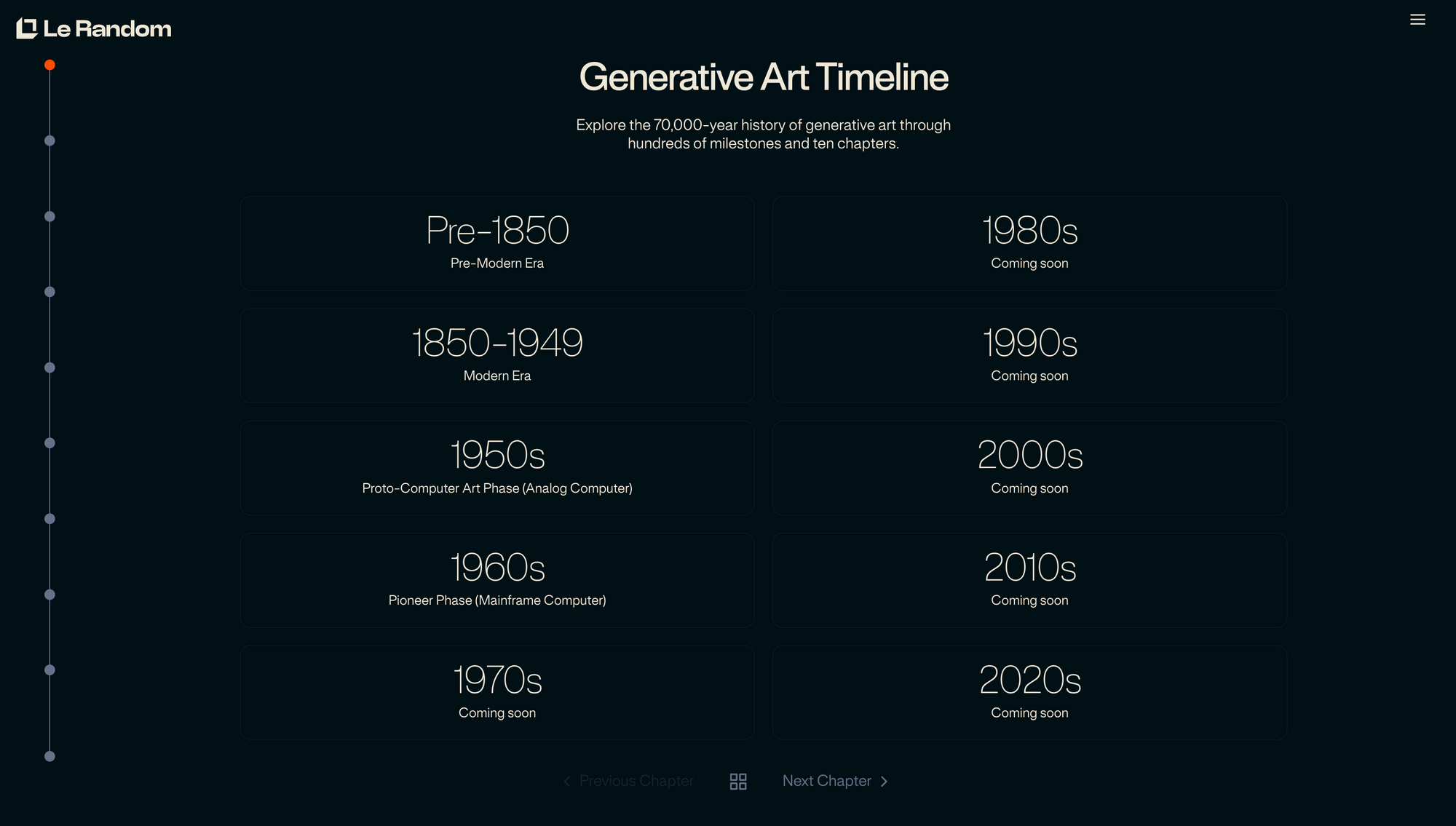
GS: Earlier this year I wrote a little piece about Vera Molnar's early life, and that was quite a difficult article to write because information on the internet is quite dispersed when it comes to events from a pre-internet era.
What's your process for building out the timeline, finding and putting together information in a meaningful manner? And what does that look like behind the scenes?
MA: I actually started working on the timeline a year ago, even before I had joined Le Random - sort of in an ad-hoc manner. Reading books about generative art, I started noting down the events that I would come across by their corresponding year. Being something that I had already worked on for a bit, with Le Random we talked about really wanting to delve into the history of generative art and decided to turn it into a bigger project.
The foundation for the timeline was laid by those first couple of books that I read.
- When the Machine Made Art by Grant Taylor
- Computer Graphics–Computer Art by Herbert W. Franke
- Art of the Electronic Age by Frank Popper
- Digital Currents by Margot Lovejoy
All of this began November of last year (2022) - the website wasn't live until June however, so I had quite a few months to start working on it and do research; it was the main thing that I was doing while we were still building out the website.
The process has been pretty monumental. There's been quite a few exhibitions back then, most of which aren't documented in any way, which makes it difficult to go into the details - sometimes you come across some obscure corner of the internet, where you find an exhibition catalogue, which then turns out to be a gold-mine of information. So as you said, the difficulty does not only lie in finding the information but also being detailed about it.
What's more is that each period of time presents it's own challenges. That's why I've been doing it decade by decade for the most part, right now wrapping up the 80s.
When all of it's done, there's probably going to be several hundreds of these moments, each one of them is like writing a mini research paper, which takes time in it's own rights. For the most part I try to use primary sources, but if there's respected secondary sources I'm also happy to draw from them directly, like Herbert Franke's book Computer Graphics - Computer Art for instance, or When the Machine made Art is also a good one.
At this point the timeline is roughly 70% finished. Whenever I'm not busy working on some other content for Le Random I try to do a few moments of the timeline each day. That's mainly how I've been doing it these days. It's a big task, and to even finish something that takes this much time you really have to love it and intrinsically be interested in it, otherwise there's no way you can finish. Luckily I'm obsessed with it, and it energizes me to just work on it - that's how I've been able to keep the momentum for so long. So I know that I'll be able to finish it in these coming months.
And I really do appreciate you and some of the other people in the community that have recognized the amount of work that has gone into it. That also definitely also helps maintain the motivation.
GS: I really appreciate the work that you do, and it shows that a lot of time and passion goes into the content. I know from personal experience how much time it takes to research and write out these things.
MA: Same to you, the newsletter that you put out, I know, again, from personal experience, that that must take time.
GS: the newsletter is still quite young, but it feels like it's worth the time, based off of the responses I've gotten so far, it seems that people are really into it.
On the flip-side, it's also sometimes a bit difficult when you put out something that you've worked on a lot, and it doesn't end up garnering much interest. How do you personally deal with that?
MA: Oh, I have plenty of experience with that. Maybe one fortunate aspect of this job is that I don't have much time to dwell on things. If I do release something and it doesn't get the response I was hoping for I'll maybe think for a few minutes about why it didn't, maybe the piece was too long, or maybe even the tweet about it was too long, or too short... or maybe it was tweeted out at a bad time, and people were busy with other things.
It's often hard to say, and you try to make your best guess, but what's important is to just stick with it, learn what you can from these experiences and then to continue. Luckily I'm in a position to do that and not even have the opportunity to dwell too much. [laughs]
GS: that's a really good way to go about it. Now that you mention it, I've also noticed that whenever a piece gets too long, it often performs worse than if it were shorter.
MA: Yeah that's true, people can get a bit overwhelmed with longer pieces. I doubt that every single word gets read by every single reader, but I do know some people that enjoy it all. So it' s a tough balance - there maybe is a hard limit.
GS: if it's a topic that has a lot of meat to it, sometimes things need to be lengthier if you want to do it justice.
Demystifying Generative Art
GS: You've written this wonderful article titled Demystifying Generative Art, it's quickly become one of my favorite pieces of writing on generative art.

I like thinking about generative art, on a conceptual level, how to asses and analyze different works, I believe that it helps us better understand what we're actually doing and why we deem certain works more interesting or valuable than others.
I've thought a lot about which category I personally would fall into, in your proposed framework - and I'd have to say that I tend towards the resultist end of the spectrum. Ultimately, the output is the tangible thing that people will interact with - it's the only connection that they can have with the concept and even the process. If the piece doesn't exist then they also can't experience any of the other aspects of it.
To go further on this, I might even say that the concept doesn't matter that much; it is often the case that generative artists have an exploratory approach where they arrive at the artwork by seeking and finding. A different perspective here would be that the concept and the process are contained within the result, essentially making the result a proof of concept and a proof of process. There isn't really a question here - but maybe you could tell us a bit more about the framework and your thoughts on this.
MA: I find it fascinating how people have been responding to the article. My original motivation for writing it was seeing a lot of discussions about appreciating generative art, but there weren't that many pieces that addressed the topic. There are a few academic papers on it, but they usually tend to be more focused on the process. There are obvious exceptions like Zach Lieberman and Tyler Hobbs for instance. Tyler Hobbs has also written about it, out of annoyance at people focusing too much on the process.

Seeing that iconic figures like Zach Lieberman, Tyler Hobbs and Casey Reas seemingly disagreed when asked the same question and felt so vastly different about the practice - further motivated me to explore the topic. I wanted to find a way to use parts of what they were saying in a more complete manner, and find a framework for thinking about generative art and appreciating it.
Concept and context I believe are obvious add-ons to process and result - as for autonomy, that element was actually one of the first things that I started thinking and writing about. After writing about Farbteiler, I did some more theoretical writing for RCS:

At the other end, generative art is inherently free of artist control. The generative artist cedes control to an autonomous system. The question of how much control they cede depends on whether they are a short-form or long-form generative artist.
What's unique to generative art in Web3 is the decentralization of creativity, and I wanted that aspect to be included in the framework. To some artists this is very central to their work, like Qubibi or Harvey Rayner.
[chuckles] There's other artists that I've interviewed, that I would definitely call autonomous, but they even replied saying that "I am not". So I understand that the framework isn't perfect, there's plenty of people who told me that they haven't found where they belong on the framework, clearly into none of those five elements at least. And I understand that, the framework was never meant to be like these are the 5 elements and there's nothing else.
It's understandable to feel uncomfortable being categorized and grouped into a specific camp so I understand wanting to resist the framework, as well as thoughts about expanding it. At the same time, all of these different and varied approaches are what make this multi-disciplinary practice so interesting, allowing for so many ways to think about it at the conceptual level.
GS: I think it's the case that a lot of artists aren't entirely certain about what they want to be or what they are actually doing, it's more of a search. It definitely is the case for me.
MA: I think that is very common. DEAFBEEF talked about this as well; a cornerstrone of his practice is experimentation and iteration, and I think that's really common. Coding just lends itself to this iterative approach.

If there were to be more parts added to the framework, it would make sense to include an element that captures the iterative and experimental nature of programming. I made a stab at this in the DEAFBEEF interview, maybe an experimentalist category would make sense but it's maybe not the most descriptive term. Do you think that might better capture your approach? But you already said you tend towards Resultism.
I think it's healthy that people are thinking about these things and trying to make the framework better, that I in no way consider complete. Even when I first started I did get a lot of feedback on it already, from people that I respect so much in the space, like Golan Levin, Zach Lieberman, etc. Now whenever I interview someone I try to squeeze in the question about it and see where they lie on the framework.
What's more, is that it also helps explain to people outside of the space why certain works are important; for instance you can't only look at the aesthetics of the 60s plotter works, from Vera Molnar for example, and judge it based on that - you also have to consider the context, and how difficult every single thing they were doing at the time was.
It's a work in progress, in the long term my aim is to write detailed deep dives about each one of the elements in the framework. But that's gonna take some time [laughs]
GS: completely agree and super excited for when these will come out. I think there maybe also needs to be a distinction between which side on the mirror you're on, if you're someone that creates art vs someone that collects/appreciates/looks at the art from the outside.
MA: That's definitely something I've thought about as well, and I probably have to clean that aspect up and somehow clarify it in the framework.
On AI Art
GS: this makes me wonder, what do you think about AI art? do you consider it generative art?
MA: I definitely think that AI art is generative, but at the same time it's a very broad topic. In a way it's that classic Philip Galanter "artist ceding control to an autonomous system", and I certainly think of AI as autonomous systems, with different degrees of autonomy. But I would certainly consider it generative.

I'm also aware that people have different views on the amount of time that goes into the creation of AI artworks, and I know that some artists look down on AI art, at least on prompt based work. There maybe is a conception that it's easy to do, and that maybe there's not much 'craft' involved in the creation of AI artworks. As someone who's worked a little bit with tools like midjourney I certainly think that you need a certain talent.
Overall I feel positively about AI art because it's giving more people the opportunity to make art. Again, some people think that that's a negative but I believe that it's a positive.
GS: Things have certainly become a lot more accessible in comparison to just a couple of years ago, but I still think there's a distinction to be made between artists that create and train their own models as compared of the prompting practice.
In generative art you usually build the system and then you harness it. When it comes to prompting you often work with models that can't be modified anymore, so it's a different kind of generative art.
I agree that there are levels of sophistication, artists like Ivona Tau, or Sofia Crespo, that use datasets and train their own models. You hope that the collectors recognize the extra effort that these artists put in, and I think they deserve all of the more recognition.
Origin of Monk Antony
Gorilla: where does your Twitter handle Monk Antony come from?
I really love history, history in all forms. At night I listen to history podcasts that help me go to sleep, and I'm always watching history documentaries - "Monk Antony" is a bit of a play on the name Mark Antony (Marcus Antonius), a political leader in the first century roman empire.
Basically, it's a nod to my love of history, and obviously there's some relation there to art history and the work I do at Le Random. It's not like it's a 20 year old nickname from when I was a kid, but it is the only handle/username since I've been in the space.
Gorilla: what about your profile picture on Twitter?
That's a one of one by Karan (Karan4d).
He just sent it to me, maybe 18 months ago now, airdropping one of ones to some of his collectors, and that just happened to be the piece he sent to me. I really love the colors in it, I'm a sucker for that sunset color palette with pinks and blues. And the person in the image kind of looked like a monk as well, so I decided to just go with that.
I didn't want to have a traditional pfp or whatever, this one was a little special, an artwork sent directly to me by the artist.
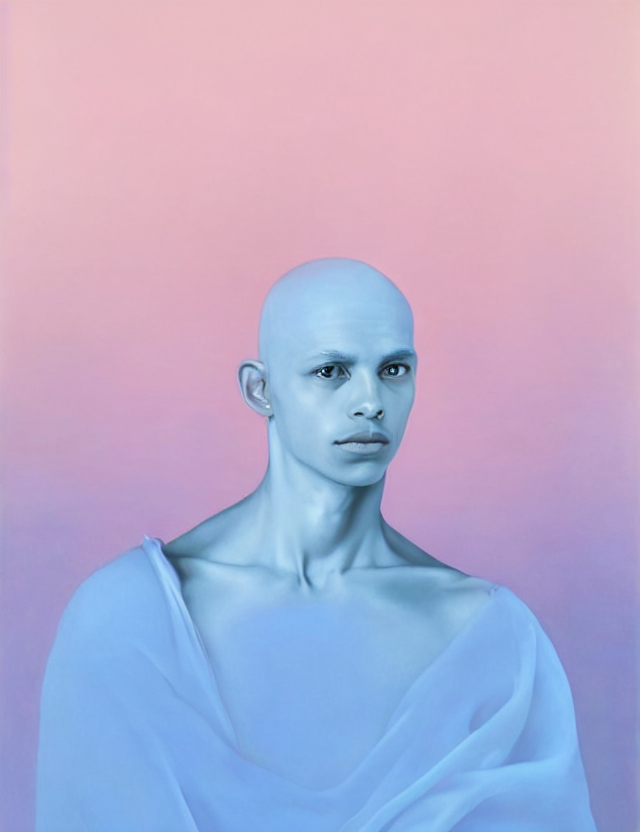
Artists to keep an eye on
Gorilla: Who are some of the artists in the space that you think are doing transformative work?
I like artists who are already thinking about doing things beyond the blockchain, beyond a hundred or a thousand outputs - artists like operator are really interesting, there's a lot of conceptual levels to their work, like they did with human unreadable, which isn't just an ArtBlocks curated project but has a choreographed score and a performance attached to it. That kind of work is really interesting.
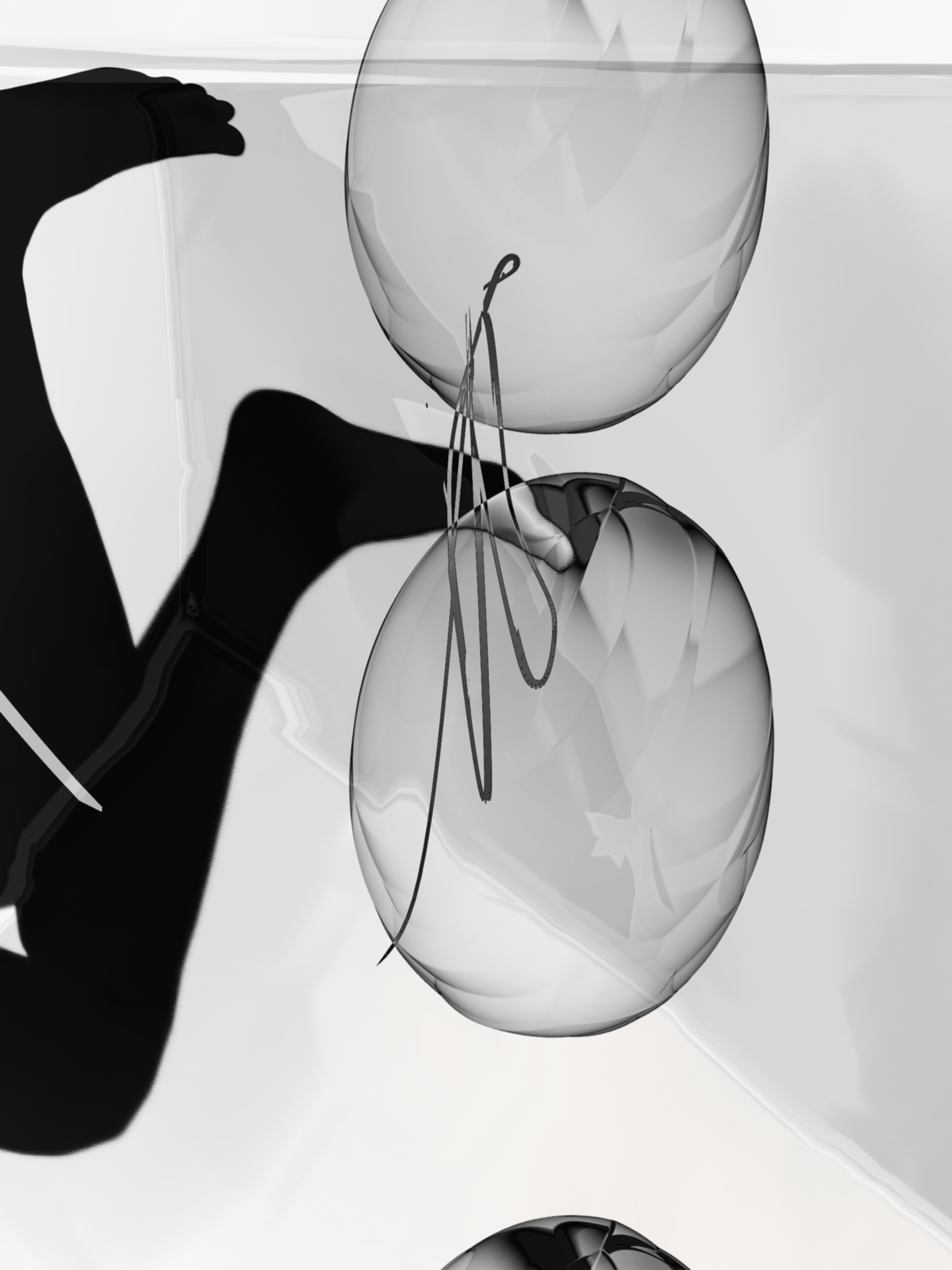
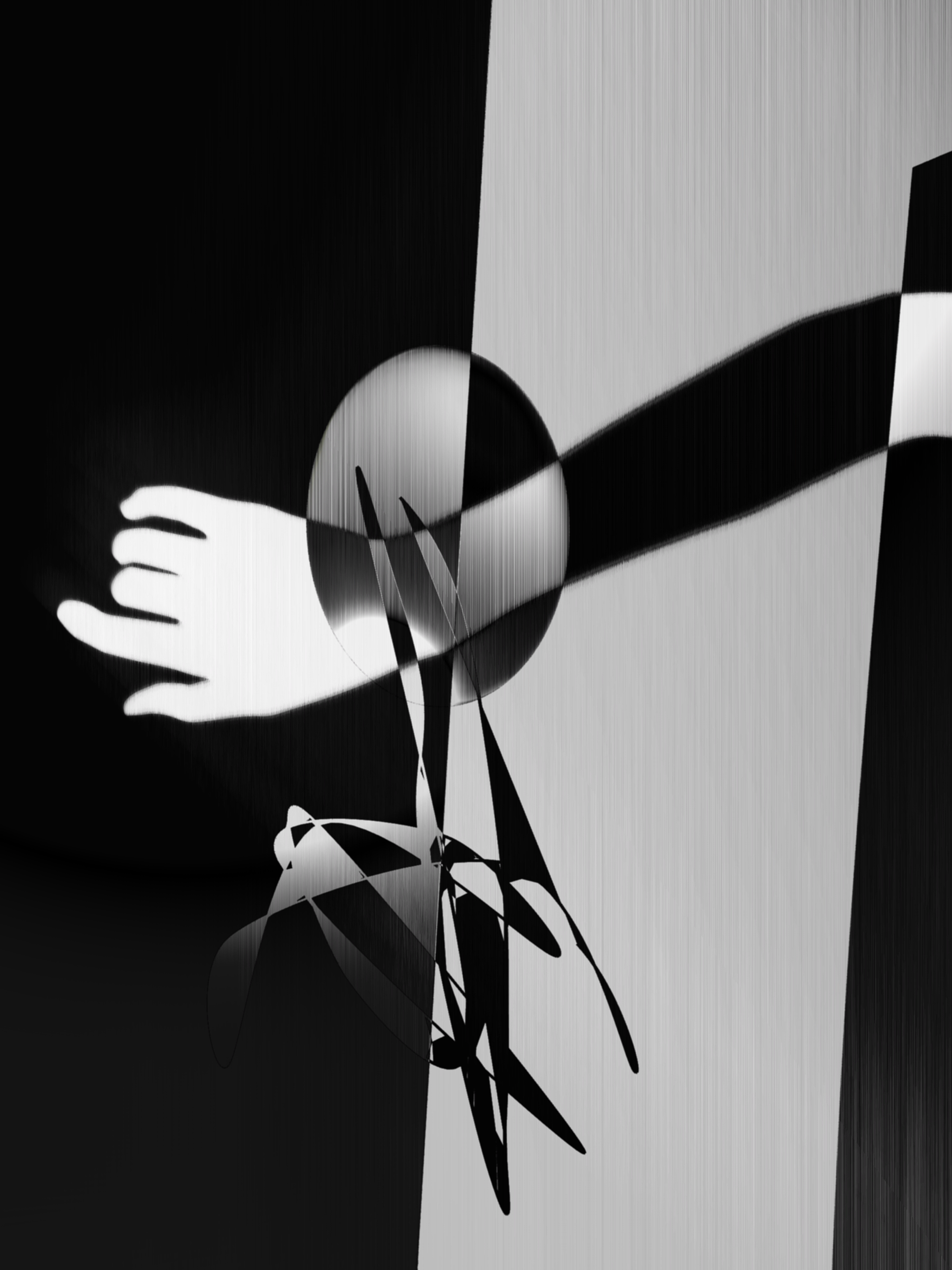
Another one is 0xhaiku, a Japense artist, and I love what he does, adding an interesting physical element he was going around Tokyo with a sort of receipt printer, where you could mint an NFT from him and he'd hand the receipt afterwards.
These conceptual pieces that are thinking about what we can do in the space in a more interesting way and go beyond the blockchain, I find those to be some of the most interesting works.
Besides that there's also artists like Rhea Myers and Maya Man, who's work aims at using the medium to criticize the medium itself. I think works like that will be lasting, when we look back there's kind of a lot of noise right now, but I think some of those artists will be what we remember. At least I will.


Concluding Thoughts
It was an absolute pleasure to talk to Peter, and I am very grateful that he took the time out of his busy day to talk to me. He's one of the truly knowledgeable people in the space, thinking about generative art, in it's current state and where it's heading in the future, at a conceptual level like few others do. I really recommend following his endeavors over at LeRandom and exploring the timeline for yourself.
Yet again, we find ourselves at the end of the article; here's the mandatory call to action - if you've reached and read this far, it most likely is an indicator that you've enjoyed this article - if you did, consider sharing it on your socials, with friends and followers, it helps tremendously and tells the algorithm that this is meaningful content.
Otherwise consider signing up to the newsletter to receive updates directly in your inbox whenever there's new content. That said, that's it from me - see you in the next one - cheers, and happy sketching - Gorilla Sun 🌸
